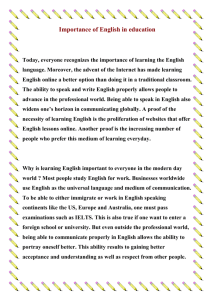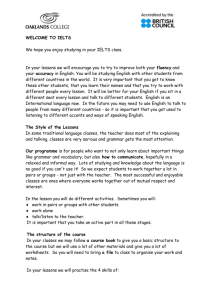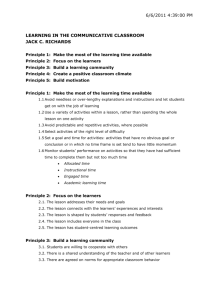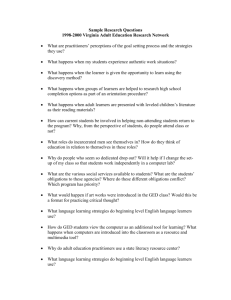Courses - International English
advertisement
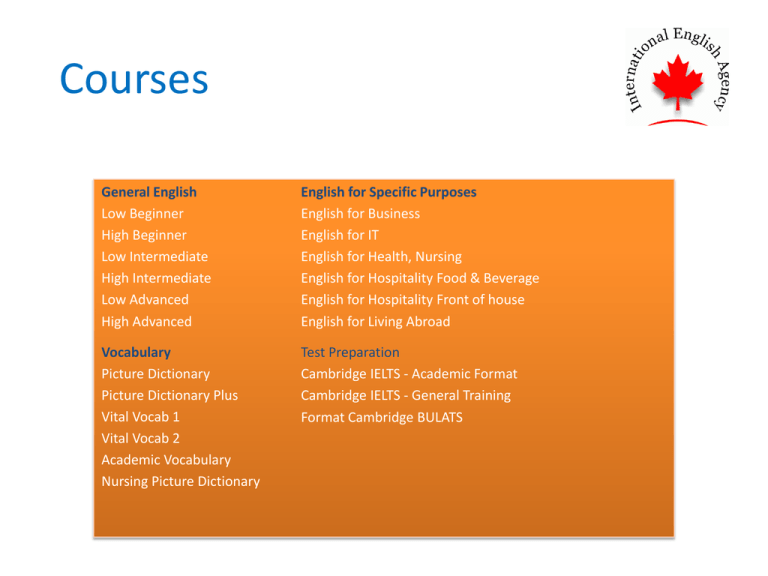
Courses General English Low Beginner High Beginner Low Intermediate High Intermediate Low Advanced High Advanced English for Specific Purposes English for Business English for IT English for Health, Nursing English for Hospitality Food & Beverage English for Hospitality Front of house English for Living Abroad Vocabulary Picture Dictionary Picture Dictionary Plus Vital Vocab 1 Vital Vocab 2 Academic Vocabulary Nursing Picture Dictionary Test Preparation Cambridge IELTS - Academic Format Cambridge IELTS - General Training Format Cambridge BULATS General English 1. Low Beginner Overview: Low Beginner enables learners to gain a general knowledge of basic English through learning how to greet others, introduce themselves to others, express their likes and dislikes and various other functions. Level: Beginner (for learners wanting to improve their general English language skills) Outcomes: At the end of this courseware, learners are expected to be able to: • identify correct responses to audio files • match images to words • read graded stories • recall language sequences • recognise correct language patterns • repeat words and sequences. • write basic words and sentences • pronounce words correctly. 2. High Beginner Overview: High Beginner enables learners to gain a general knowledge of basic English through learning how to greet others, introduce themselves to others, express their likes and dislikes and various other functions. Level: Beginner (for learners wanting to improve their general English language skills) Outcomes: At the end of this courseware, learners are expected to be able to: • identify and understand target vocabulary • recognise information about topics studied • read and write simple texts related to unit topics • speak about preferences, their friends, daily routine 3. Low Intermediate Overview: Low Intermediate enables learners to gain a general knowledge of basic English through practising commonly used vocabulary and language chunks such as greeting others, introducing themselves and others, expressing their likes and dislikes and various other functions. 4. High Intermediate 5. Low Advanced 6. High Advanced High Advanced enables learners to improve their knowledge and use of English by following a skills-based approach to language learning. Key concepts or learning strategies are identified and practised in relation to each of the skill areas using a variety of interactive exercises. Cambridge IELTS Overview: The Cambridge IELTS courses offer a flexible and stimulating way of studying using authentic practice materials. Modules are broken down into learning‘chunks’ so that learners can make best use of small blocks of time. The courses provide learners with the opportunity to improve their listening, reading, writing and speaking skills, while also enhancing their knowledge of grammar and vocabulary. The Cambridge IELTS courses provide learners with the best possible chance of succeeding in the IELTS test. Intermediate to Advanced The online self-study course provides practice activities for learners who are aiming for an IELTS band score of between 4.5 and 7.5. The first blended course is aimed at an IELTS 4.5 – 5.5 range and the second blended course is aimed at an IELTS 6.0 – 7.5 range. The courses are suitable for first-time testtakers as well as those who are repeating the test. Learning outcomes: Learners should be able to apply the skills and strategies taught throughout the courses to successfully complete the IELTS test. Suggested hours of learning: The self-study course consists of the following: Listening (25 hours) Academic Reading (25 hours) General Training Reading (25hours) Academic Writing (25 hours) General Training Writing (25 hours) Speaking (25 hours) Blended Courses: In both blended courses, the main focus of the classroom component is on the productive skills (writing and speaking) while the main focus of the online component is on the receptive skills (listening & reading). This format is flexible with various other combinations possible to suit the needs of individuals and organisations. Blended Course 1 (4.5 – 5.5) The lower level blended course has been designed so that approximately 30% - 40% of the resources can be delivered in a classroom situation while 60% - 70% can be accessed online. • Academic Reading (25 hours) • Academic Writing (25 hours) • Writing (25 hours) • Speaking (25 hours) Blended Course 2 (6.0 – 7.5) In the second blended course, 25% - 30% of the resources have been designed to be delivered in a classroom situation while 70% - 75% of the resources are delivered online.
